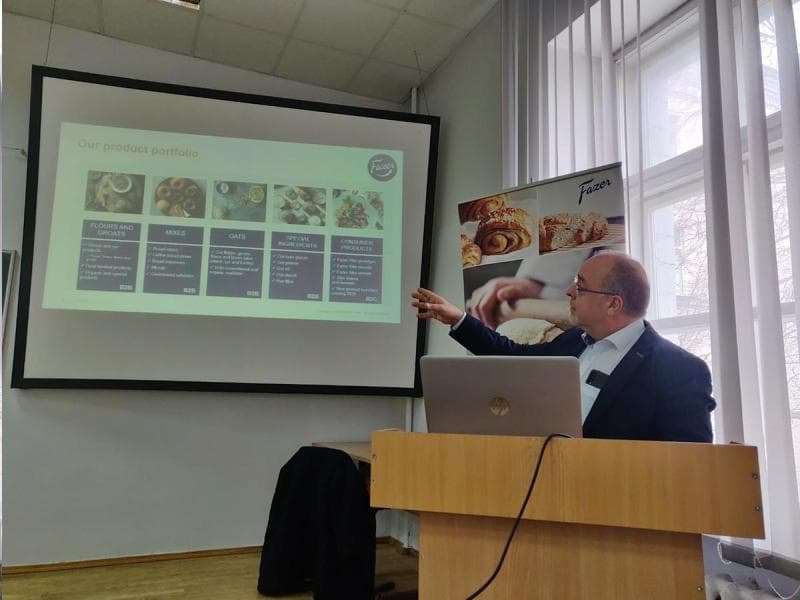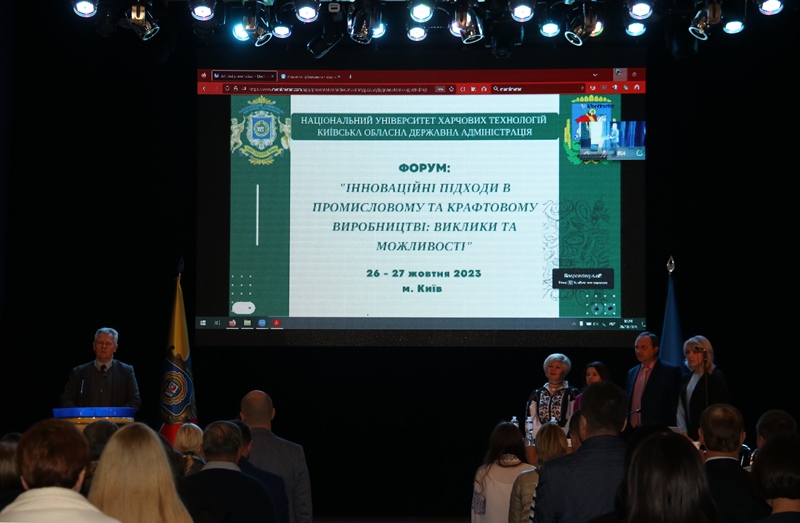- BACKGROUND (middle of the XIX century)
- ESTABLISHMENT (1884)
- FORMATION (1884-1917)
- QUALITATIVE PROGRESS IN STATUS (1917-1929)
- RELOCATION OF INSTITUTE TO KYIV (1930)
- DEVELOPMENT (1930-1941)
- IN THE HARDSHIPS OF WAR (1941-1945)
- BEGINNING OF THE PROSPERITY PERIOD (1945-1974)
- STEADY PROGRESS (1974-UNTILL NOW)
BACKGROUND (middle of the XIX century)
On 30 August 2014, the National University of Food Technologies (NUFT) celebrated one hundred and thirtieth anniversary of its foundation. NUFT is one of the oldest educational institutions of Ukraine which trains specialists for all branches of the food and processing industries.
The University history is a vivid reflection of the economic development of Ukraine, its scientific and technological progress, socio-political and cultural life.
On the one hand, the foundation of the specialized educational institution is connected with the development of education in the Russian Empire, the creation of the Kyiv branch of the Russian Imperial Technical Society, and, on the other hand, with the need to train top and middle level engineers and technicians for sugar beet manufacturing which was intensively developing at that time.
Thus, the history of the National University of Food Technologies, whose origins date back to the second half of the ХІХ century, is closely connected with the history of the development of the sugar industry.
At that time, 84% of all-Russian sugar production was manufactured in Ukraine, and if there were only six sugar refineries in Ukraine in 1830, then in 1848 there were already 192 of them.
The enterprises of the count Oleksiy Bobrynskyi needed highly skilled employees. Oleksiy Bobrynskyi was a sugar manufacturer considered to be the founder of the sugar industry in Ukraine and whose efforts made Kyiv as the "world sugar capital" and the Russian Empire became one of the largest producers of sugar. In 1858, O. O. Bobrynskyi established an elementary school of Smila sugar refinery. It provided a three-year course and a training program corresponded to the curriculum of the church school. About 30 people finished school every year, and low income students studied there on a tuition-free basis.
There was a problem of shortage of skilled personnel for the sugar industry and the opening of a specialized educational institution became an urgent matter. The ways of the problem solution had been discussing in printed media since 1862.
In 1866, eleven private citizens and (prominent industrialists, engineers, and teachers of the University of St. Petersburg) initiated the foundation of the Russian Technical Society whose purpose was to promote the development of technology and factory indystry (in 1874 the Society was awarded the title of the Imperial Society).
In 1871, according to the decision of the Kyiv branch of the Russian Technical Society, leading scientists such as Professors D.I. Mendeleev, O.M. Butlerov, F.M. Garnych-Garnytskyi, P.P. Alekseev, M.A. Bunge and others were giving courses of public lectures and donated their fees to the fund for opening the school for sugar refiners. The owners of sugar refineries also donated money to open the school.
At the same time, in the period from 1874 to 1877, the founders of the school faced an acute problem of lack of capital and as a result school statute wasn't adopted, despite the fact that the Technical Society in 1877 received the prior consent of Count Volodymyr Bobrynskyi (son of Alexei Bobrynskyi) to become the Honorary Warden of the school.
In 1874, E.M. Andreev, the Chairman of the Commission on Technical Education of the Russian Imperial Technical Society, developed a draft law on labour and education of minors. In 1882, the Draft was approved as the Regulations on Schools that were under the authority of the Technical Society. According to it, the Society was allowed to open schools at factories and plants. The schools were divided into two categories: schools and special classes (technical, vocational, drawing, painting) and general educational schools.
ESTABLISHMENT (1884)
The Regulations on Schools made it possible for the Kyiv branch of the Russian Imperial Technical Society to adopt a decision to open technical classes in the town of Smila on the basis of Bobrynskyi School on 15 February 1884. As a result, on 22 March 1884, a statement to the Warden of Kyiv Okrug (District) was submitted to obtain the permission to open classes, which was accompanied by a draft statute prepared by prof. M.A. Bunge.
-
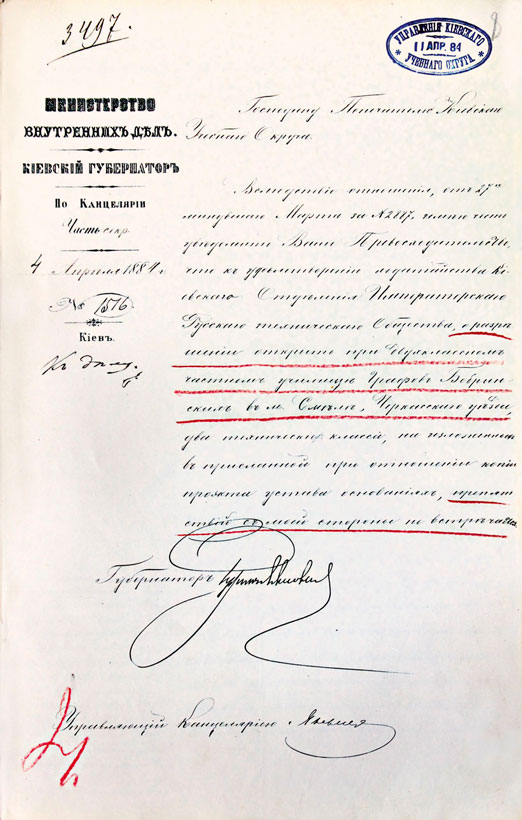
Letter of Approval on opening of Smila classes from Kiev Governor to the Warden of Kyiv Educational Okrug (District)
Such a permit was obtained after the approval of Kyiv Governor. By Circular Letter No. 3279 dated 16 April 1884, the Warden of Kyiv Educational Okrug (District) gave a permission to open two-year technical classes in Smila. With the personal consent of Emperor Alexander III, Count Volodymyr Bobrinskyi became Honorary Warden of these classes and allocated significant funds for their opening. Thus, a specialized technical school was set up to train technologists, chemists and foremen of sugar production.
School location was determined both by objective (the main production of sugar beets was concentrated there) and subjective factors (the activity of the local authorities, who filed a petition and contributed to opening of the school).
Up to that time, the training of specialists for the sugar industry was not systematic. Only some of the educational institutions included this field of study in their curriculum. Thus, the University of St. Petersburg, established in 1828, played a major role in training specialists for sugar production. The compulsory course of technology and technical chemistry, which included "Sugar production" course, was taught by professor P.A. Illienkov, and later by professors M.V. Skoblikov, M.M. Liubavin, D.I. Mendeleev. More than 250 engineers and technicians graduated from St. Petersburg University in total. Specialists in sugar refinery were also trained at Moscow Vocational School (Moscow Higher Technical School since 1868).
Professors P.P. Alekseev, M.A. Bunge, T.I. Lonachevskyi-Petruniaka took part in the creation, and scientific and methodological support of sugar processing technology at Kiev Imperial University of Saint Vladimir.
Specialists in sugar manufacturing were also trained at Kharkiv Practical Technological Institute. I.A. Krasuskyi, a graduate of the natural science department of Kiev Imperial University of Saint Vladimir attended lectures during two semesters and had a practical course on sugar refining and sugar beet growing in the laboratories of Zurich and Brunswick polytechnic schools. He also received practical experience in sugar production while working at sugar plants: one year practice in Germany at the Twulpstedf plant and one year practice at Andrushkovka plant in Russia. Ivan Krasuskyi worked at Kharkiv University as a laboratory assistant in the agronomic laboratory since 1893. After passing the exam for getting master's degree in chemistry, he got the right to lecture as a privat-docent at the department of chemistry.
FORMATION (1884-1917)
According to the Statute, Professor M. A. Bunge became the first head of Smila technical classes. The classes had a possibility to teach students on the premises of the factory school (opened by A.O. Bobrynskyi) on the territory of the sugar refinery. The educational process was organized so that both educational institutions worked independently of each other. The selection of teachers and funding of the institution met the necessary requirements.
One of the main aspects of the success of Smila classes was a good combination of theory and practice. From morning till noon, there were practical classes in the laboratories and workshops of Smila sugar refinery, and afternoon was devoted to the theory. After passing exams, students reinforced acquired skills and abilities during two summer months while working at plants, including reconstruction period at plants before the beginning of the season of sugar refining.
After completing the course of theoretical studies each graduate had to work at a sugar refinery for two years and receive positive recommendations from the administration about his behavior and activities, as well as provide a detailed written report with explanatory drawings, after consideration of which he was awarded a certificate from the Russian Technical Society.
Since technical classes trained middle managers, students were taught many supplementary courses. In particular, during the second term at weekends and holidays, they listened to the lectures on hygiene, which were given by Dr. B.S. Kozlovskyi at the beginning of the twentieth century. In extracurricular time, graduates also studied the rules of excise supervision of a sugar plant, excise accounting and maintenance of relevant documentation.
Significant funds were spent on social needs. Thus, classes kept a common apartment (hostel) at their own expense, paid aid to the poorest students, paid for medical assistance. Even before receiving the status of school, Smila technical classes became an example of good organization of educational process. Thus, the school of Count Bobrynskyi was awarded the Gold Medal at the first All-Russian hygienic exhibition in St. Petersburg (1893). Smila technical classes received the 1st category diploma at the XVI All-Russian Industrial and Art Exhibition (1896, Nіzhnii Novgorod). At Kyiv Agricultural Exhibition in 1897, they presented their own exhibition show window. Many publications in periodicals, the favourable reviews in the Niva magazine and the article written by Professor V. Voikov (1892) in particular, were a testimony to the testimony of influential role of classes in the society.
Official institutions positively evaluated the activities of the classes. Thus, in 1904, according to a separate note, they were included in the report of the warden of Kyiv Educational Okrug (District), although at that time only institutions with school status were included in this list. The warden, in particular, distinguished the achievement of classes in dissemination of professional knowledge and their qualitative improvement, as well as well-equipped laboratories and workshops, high level of teaching staff.
Since 1903, studies in technical classes lasted three years. As rapid progress of the industry required from future specialists not only professional, but also sound engineering knowledge, a preparatory class was opened where drawing and construction works, religion, physics, chemistry, mathematics, and natural history were taught. Sugar manufacturers provided tuition fee for low-income students. Nominal scholarships of Emperor Alexander II and prominent scholars and engineers of the industry (e.g. scholarships of M.A. Bunge, I.D. Musatov, M.O. Tolpygin, etc.) were given for academic achievements.
The classes finally received their own premises in 1906: Count Lev Bobrynskyi built an educational building on Rafinadna Street (preserved to this day) at his own expense.
Professor G.G. De-Mets was the head of the classes from 1906 to 1917. From 1884 to February 1917 the technical classes trained 440 qualified specialists, among them there were both managers of sugar plants and prominent scientists. In particular, I.A. Kukharenko, the founder of the theory of sugar crystallization and the future head of the sugar technology department of the Kiev Technological Institute of Food Industry, graduated from Smila technical classes.
-

Educational process of Smila technical classes (1890s)
-
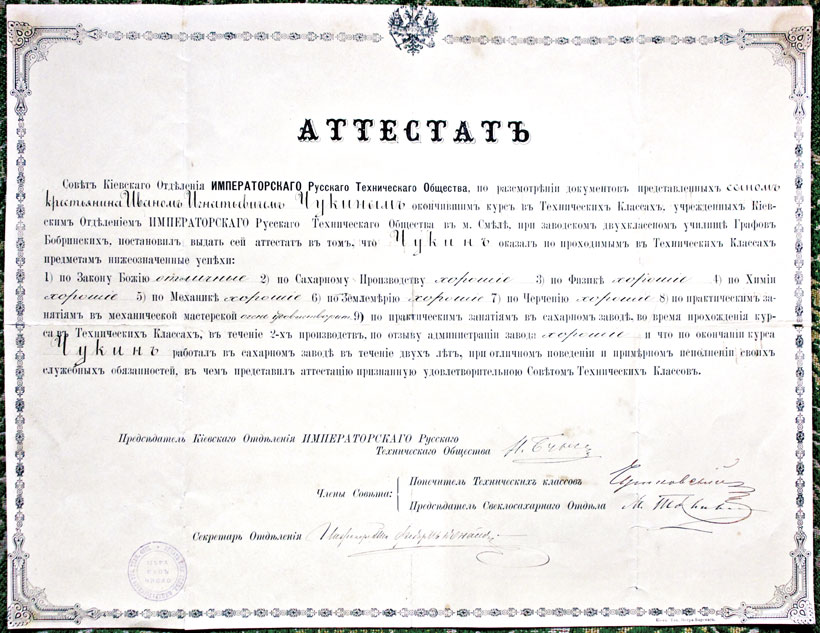
Certificate of completion of Smila technical classes (1890)
-
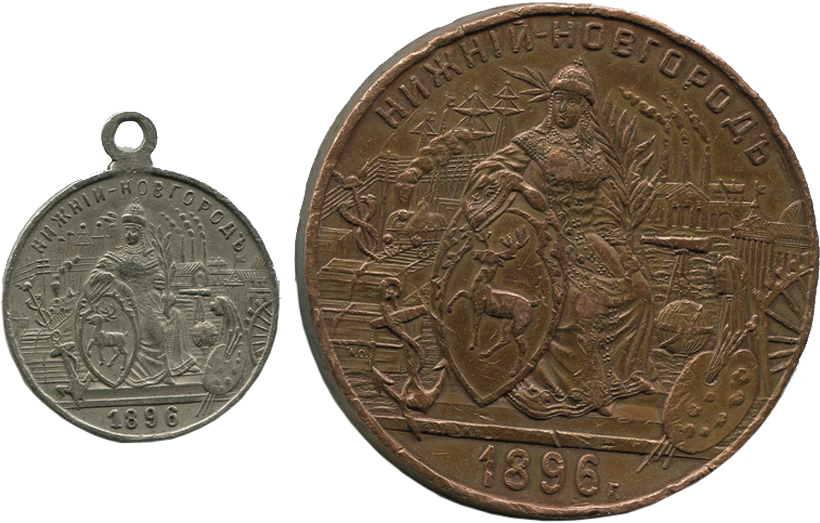
Awards of Smila technical classes at the exhibition in Nyzhnii Novhorod (1896)
-
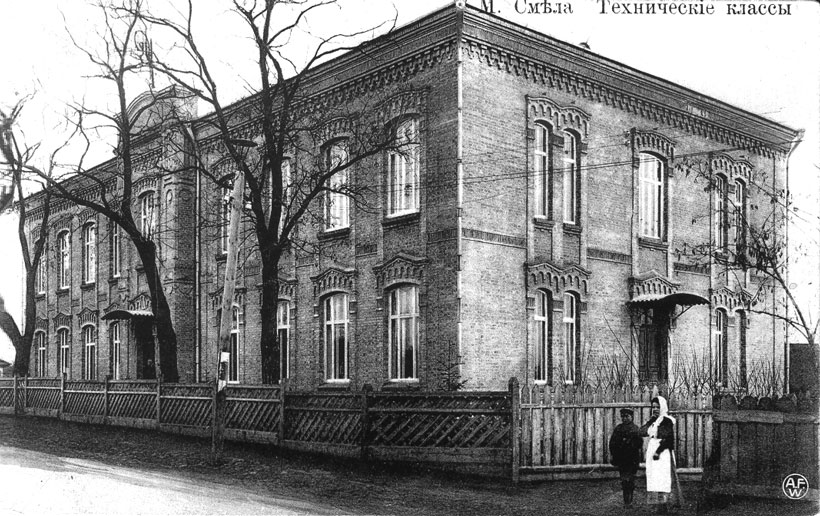
Premises of Smila technical classes built by count Lev Bobrynskyi (1906)
QUALITATIVE PROGRESS IN STATUS (1917-1929)
In the spring of 1917, Smila classes received the status of a secondary chemical and technical school with a 4-year course of study according to the decision of the Ministry of Public Education. V.K. Nahornov became the head of the school. In the summer of the same year, the Russian Technical Society stated: "Until now, Smila technical classes in their 34th year of existence have been the oldest educational institution which trained specialists in sugar refining not only in our region but also throughout Russia. With general developent and improvement of vocational education in the country and modernisation of the sugar industry, higher requirements will be imposed on technical classes which can only be met through transforming classes into a secondary chemical and technical school." The interest of the Provisional Government in training specialists for the sugar industry is clearly evidenced by the increase in school funding: from 16 432.5 rubles to 32 525 rubles a year.
The turbulent events of 1917-1918 influenced the work of the educational institution. German occupation of Smila in 1918 and the uncertainty of the Directorate period after it negatively affected the activities of the school. First of all, it influenced the material base: a part of the workshop equipment was taken to Germany, and part of the laboratory equipment was destroyed by the Smeliansk Hundred of Free Cossacks of Y. Vodianyi during the pogrom. However, despite these unfortunate circumstances, teachers and students found the courage to continue educational process. These efforts were not in vain and soon led to a qualitative progress in the status of the educational institution.
In 1918, O.S. Sokolov, a graduate of the natural sciences faculty of Petrograd University, headed Smila Chemical and Technical School and maintained its development in the difficult times of political and economic changes. Since the beginning of the NEP, the school was reorganized into the Technical School of the Sugar Industry, and next year a vocational school was opened on its premises. In 1922, two technical departments were organised at technical school: the mechanical department and sugar beet production department to satisfy the needs of the sugar industry of that time.
Thus, the beginning of the 1920s can be considered as the starting stage of the branching of the educational institution: along with the high school (Smila Technical School of the Sugar Industry), there also functioned a secondary special educational institution, Smila Vocational School. In the report on the summer trimester of 1923, the technical school was qualified as a higher educational institution, whose graduates in sugar refining successfully worked in all republics of the Soviet Union.
There was also an idea to open a chemical department. A note on syllabus preparation for Smila Vocational School and the Technical School of the Sugar Industry stated: «... the chemical department most closely approached to the satisfaction of actual needs of the sugar industry. But at the same time, it stands apart from the mechanical and agronomic departments being a kind of an independent educational institution.»
During the admission period in 1923, it was specified that the course of study at vocational school would be two years, and at technical school it would be three years. To enter vocational school, it was required to graduate a seven-year labour school in Ukraine or the first two classes of a second-level secondary school for Russian-borns. The admission was based on the results of the examinations on political literacy, arithmetic, algebra, geometry, natural science and positive assessment of written essays in Ukrainian or Russian. The conditions of admission to all three departments of the vocational school were the same.
To enter the technical school, it was required that the entrants completed the vocational school according to/in the relevant specialty and took entrance examinations, both in general and special subjects. Thus, entrants to the chemical department were required to have sufficient knowledge of political literacy, arithmetic, algebra, geometry, trigonometry, physics, sugar production, inorganic chemistry, as well as to write a free essay in Ukrainian or Russian and draw a sketch from life. To enter the mechanical department, sufficient knowledge of the aforementioned school subjects was required, as well as passing test tasks on woodwork and metalwork. Applicants who passed exams on political literacy, arithmetic, algebra, geometry, trigonometry, physics, fundamentals of inorganic chemistry, botany, zoology and wrote an essay on a given topic could become students of the agronomic department (closed in 1924).
Transformation of the chemical and technical school into the technical school increased the requirements for educational process. P.M. Kyslynskyi, who replaced O.S. Sokolov, became the first director of the technical school.
The beginning of his activity was marked with a significant renewal of the teaching staff. P.M. Kyslynskyi managed to attract O.Yu. Archypovych, a privat-docent of Kyiv Polytechnic Institute and the director of Cherkasy Institute of Public Education; K.O. Kurbatov, a teacher of Petrograd Polytechnic Institute; I.V. Lindeman, a member of the Ukrainian Academy of Sciences; І.P. Chefranov, a candidate of physical and mathematical sciences.
Renewal of the teaching staff made it possible to improve the efficiency of training within a short period of time. By 1924, Smila Technical School became the only technical school of sugar production not only within Ukraine but also in the Soviet Union. Graduates of the technical school received qualifications of engineer-chemists and mechanical engineers. On the initiative of P.M. Kyslynskyi, the Ministry of Vocational Training of Ukraine decided to open a department of mechanical engineering (1926), as «the foundations of machine building and design of sugar refinery equipment in particular, constitute the core disciplines of technical school».
The decision of the Ministry of Vocational Training of Ukraine to close the vocational school was a significant problem for the staff as more than half of their students began their education in it and entered the technical school having profound professional training. P.M. Kyslynskyi, as the director of the technical school, made a lot for its revival, and the vocational school was reopened by the decision of the People's Commissariat of Education of the Ukrainian SSR and welcomed students on 1 January 1929.
The importance of an educational institution for the sugar industry of the Soviet Union made it necessary for teachers to grow professionally. In 1928, six professors of the second level (according to the current classification of scientific degree of that time) worked at technical school and P.M. Kyslynskyi was awarded the title of a professor.
Taking into account the high level of training and active scientific activity of the teaching staff, the Collegium of the People's Commissariat of Education of the USSR approved a decision to establish Smila Sugar Institute on the basis of the technical school on 28 November 1929.
P.M. Kyslynskyi worked as the director of the institute for a short period. He was arrested on 22 March 1931 and sentenced to four years of exile in Vologda on the grounds of a fabricated case of the «criminal» Prompartiia (the Industrial Party) organization. He did not return to Smila. P.M. Kyslynskyi was fully exonerated only on 24 April 1959.
The turn of the 1920s and 1930s was marked by fundamental transformations in the national economy, creation of new and reconstruction of existing industries. The problem of the shortage of engineers was acute.
-
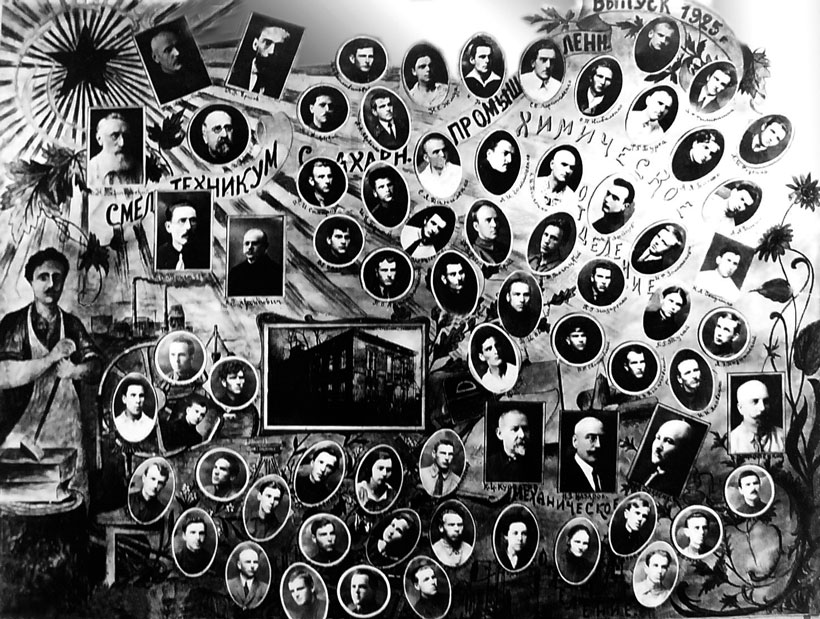
Graduation photo of Smila Technical School of Sugar Industry (1925)
RELOCATION OF INSTITUTE TO KYIV (1930)
In 1930, the Kiev Institute of Sugar Industry (KISI) was founded on the basis of Smila Institute of Sugar Industry, as well as sugar departments of Kamianets-Podilskyi Chemical Institute and Kiev Polytechnic Institute. The institute had three faculties: sugar (chemical), mechanical (equipment for sugar refineries) and economic. It functioned under Soiuztsukor (Sugar Assosiation) of the USSR People's Commissariat of Trade. After a large-scale reorganization, V.B. Fremel, doctor of technical sciences, professor, honored scientist of the Russian Soviet Federative Socialist Republic, headed the institute (1930-1931).
In accordance with the general plan for the construction of higher educational institutions in Ukraine, the construction of educational building started in the vicinity of Povitroflotskyi Avenue. Soiuztsukor allocated over 3 million rubles for these needs, and in November 1931 the institute received its own premises (until then students studied in Smila and Kyiv departments).
In 1930, 450 people were enrolled in the institute. New curricula and syllabuses were actively developed at six departments. Departments of sugar production of Kharkiv and Leningrad technological institutes became a part of the institute, and it was named the Kyiv Institute of Sugar Technology (KIST).
-

Certificate of completion of training at Smila Institute of Sugar Refinery (1930)
-
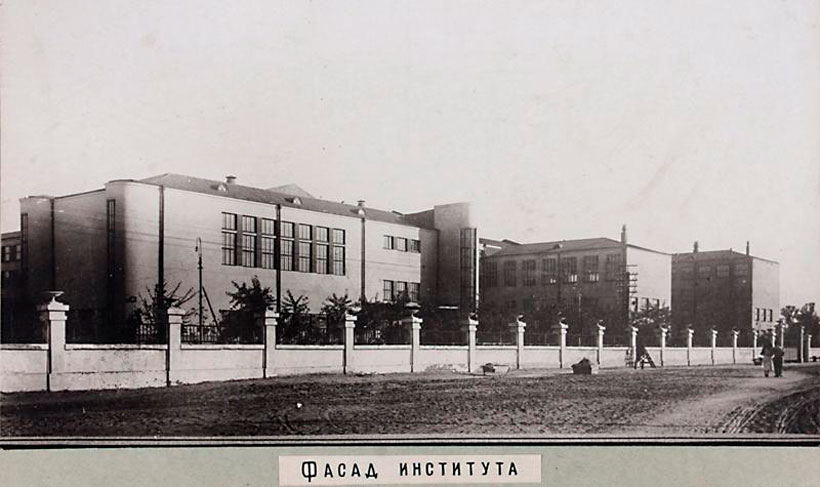
Educational building of the Institute on Povitroflotskyi Avenue in Kyiv (1931)
DEVELOPMENT (1930-1941)
P.F. Nemynushchyi, an institute graduate, became the next director in 1932. He died a premature death at the age of 36.
Study rooms were almost completely equipped at that time; student hostels, a library, a canteen, a residential building for the teaching staff, educational workshops, a sports complex were being built, laboratories and study rooms were equipped with modern equipment. The Museum of Sugar Industry was created on institute premises. Experimental distillery and sugar plants, X-ray room were functioning.
The fate of F.K. Stefanskyi, the successor of P.F. Nemynushchyi, also a graduate of the Kiev Institute of Sugar Technology is a bright illustration of Stalin era (1932-1937). Being the Civil War veteran, awarded with the Order of the Red Banner, he was sent to work at Oblcharchoprom (the Regional Food Industry Orgaisation) in 1937, then he was persecuted for political reasons and perished in the days of Stalin’s Terror.
In 1933, a number of new institutes, faculties and departments of chemical, technological and food specialisation were incorporated into KIST: the Kyiv Confectionery and Fermentation Institutes, the mechanical faculty of the Voronizh Chemical and Technological Institute of Food Industry, the faculty of agricultural mechanization of Bila Tserkva Agricultural Institute and the mechanical faculty of Poltava Institute of Meat Technology. Hence, KIST was renamed the Kyiv Chemical and Technologial Institute of Food Industry (KCTIFI). It had three departments: mechanical, chemical-technological and economic.
The student body also grew in number. If in 1930 there were 450 students, in 1931 there were 824 students, and almost 2,000 students studied in it in 1937-1938. In five years’ time (1932-1937), the institute trained 1200 food industry engineers, economists and mechanical engineers for the food industry. That was due to the work of highly qualified teaching staff, namely academicians M.P. Kravchuk, M.M. Boholiubov, M.V. Ptukha, professors I.A. Kukharenko, V.I. Mozhara, G.G. De-Mets, P.V. Golovin, M.A. Kondak, M.A. Kichigin, A.A. Fuks, O.O. Kirov and others.
In 1935, KCTIFI was renamed the Kyiv Technological Institute of Food Industry after A.I. Mykoian (KTIFI). Under this name, it not only gained recognition and took a prominent place among higher educational institutions of the former Soviet Union, but also became well-known far beyond the USSR borders.
At that time, training of own scientific and pedagogical staff became a priority. Since 1935, the institute was granted the right to award a scientific degree of the candidate of science and to accept doctoral dissertations for further defence. Scientists of the institute were involved in the design of equipment and introduction of advanced technologies in food industries.
For the same reason, a research center was created on the institute premises in May 1934. In the 1930s, a large number of students took part in scientific research there. KTIFI hold leading positions among student groups of other institutions in the organisation of cultural entertaining and sports activities and also in youth preparation for the defence of the Motherland.
In 1937, M.A. Mikulin became the director of the institute (1937-1938). In those years, sporting and mass participation events and defensive activities were organized; much attention was paid to military-patriotic education. The institute organized volleyball and football teams, motorcycle, automobile, radio engineering and other circles. Much attention was paid to the development of student amateur activities. The institute had its own club with a large assembly hall. Drama, choir, literary, choreographic clubs, string, domra and brass bands, the Ukrainian dance ensemble were actively functioning.
Since 1938, the Institute was headed by Ya.E. Katz, a graduate of KTIFI, the dean of the mechanical faculty (1938-1941). In 1941, he organized the evacuation of the institute to the rear, while he himself remained in Kyiv for underground work and was killed by the fascists.
During ten pre-war years, more than 2,500 food industry engineers, mechanical engineers, and economists were trained at the institute, which was three times as high as the total number of specialists working in the food industry of the Soviet Union.
The Kiev Institute of Food Technology has become one of the leading higher educational institutions in the country. In the academic year of 1938-1939, the institute was included into the Book of the Best Higher Educational Institutions of the Republic, and in February 1941 it was considered the best educational institution among those of the Commissariat of Food Industry of the USSR.
-
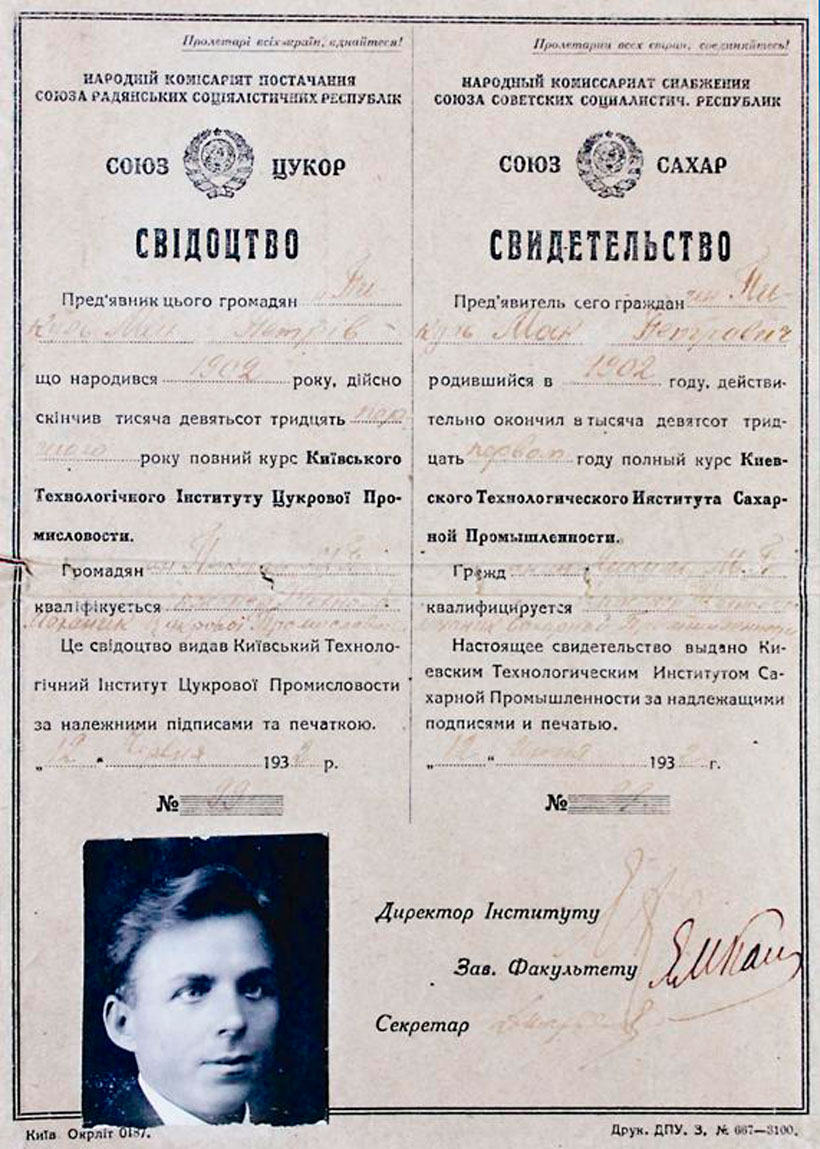
Certificate of completion of training at the Kyiv Technological Institute of Sugar Refinery (1932)
-
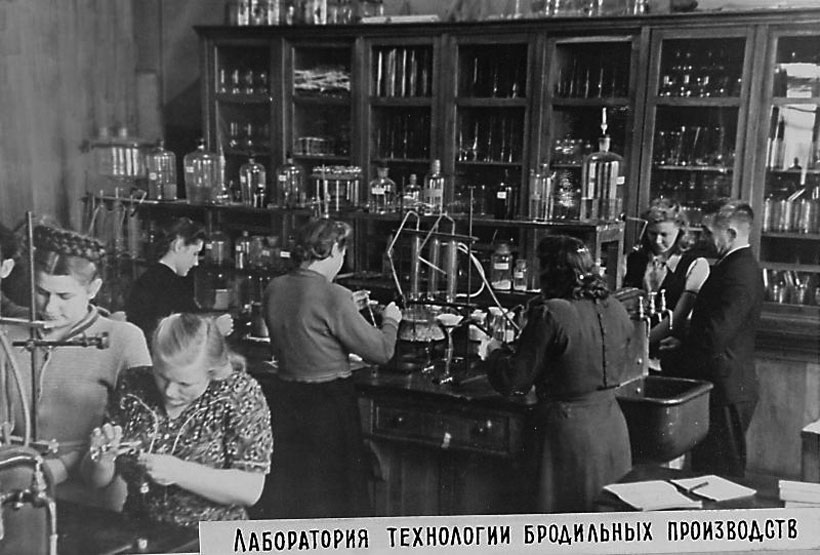
Educational process in the fermentation laboratory (1930s)
IN THE HARDSHIPS OF WAR (1941-1945)
In the years of the Second World War, the staff of the institute concentrated main efforts to resist the enemy without interrupting educational process. Volunteers formed a fighter battalion; teachers and students worked on the construction of defense fortifications around Kyiv. More than 600 teachers and students joined the ranks of the army. During the evacuation from the city, institute staff made every effort to move the most valuable equipment and people to the rear, at first to Voronezh, where the educational process took place at the local chemical-technological institute, and then to Biisk of the Altai Territory (1942).
In November 1943, immediately after the liberation of Kiev, the institute staff returned from evacuation. Professor O.A. Kamieniev was appointed director of KTIFI. The main task for the institute administration was to organise educational process having the shortage of necessary equipment and a large number of destroyed premises.
In March 1944, I.G. Hrytsiuk became the director of KTIFI. Having great experience as an administrator and scientist (in the 1930s he took part in the creation of the technical school of the distillery industry, he graduated from the postgraduate course at KTIFI just before the war, and in 1943, being the chief engineer, he put into operation a distillery plant in Kirov Oblast ahead of schedule), the new head directed efforts to rebuild the educational institution. The vigorous and effective actions of KTIFI administration and staff are evidenced by the fact that the pre-war number of teachers and students had been reached by Victory Day (9 May 1945).
-
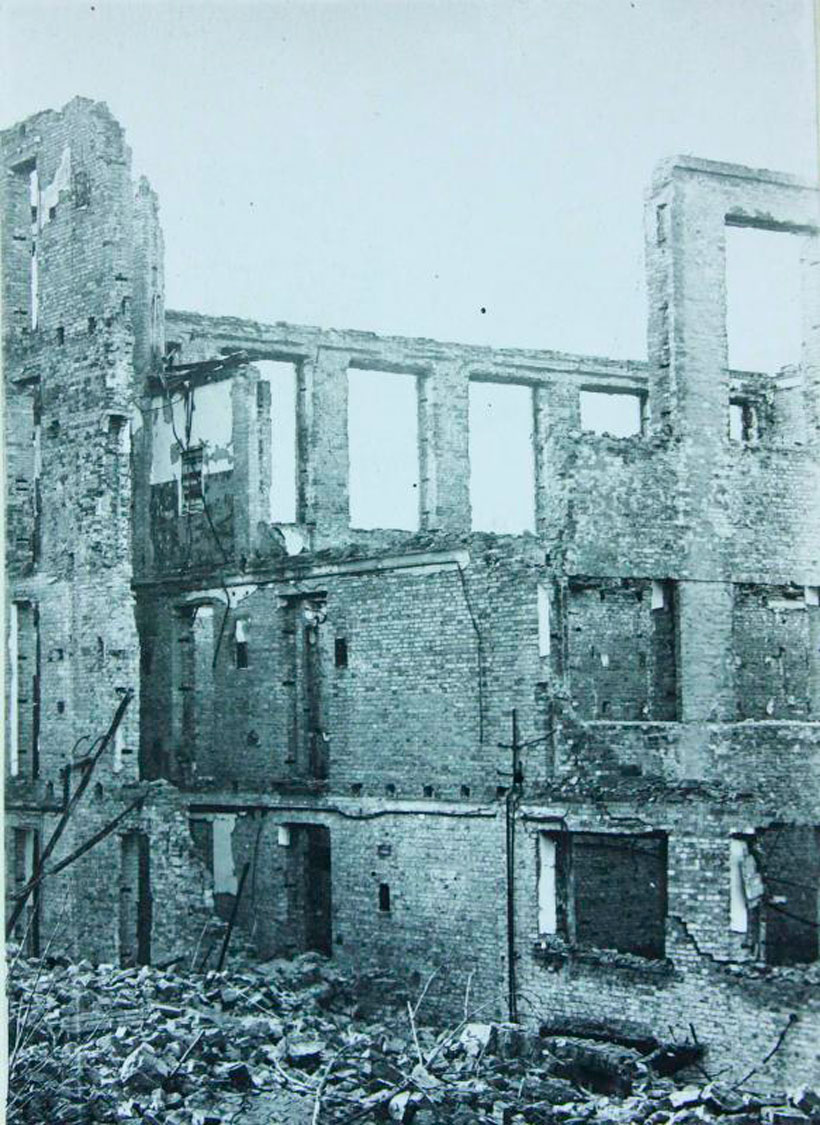
Ruins of the University buildings
-
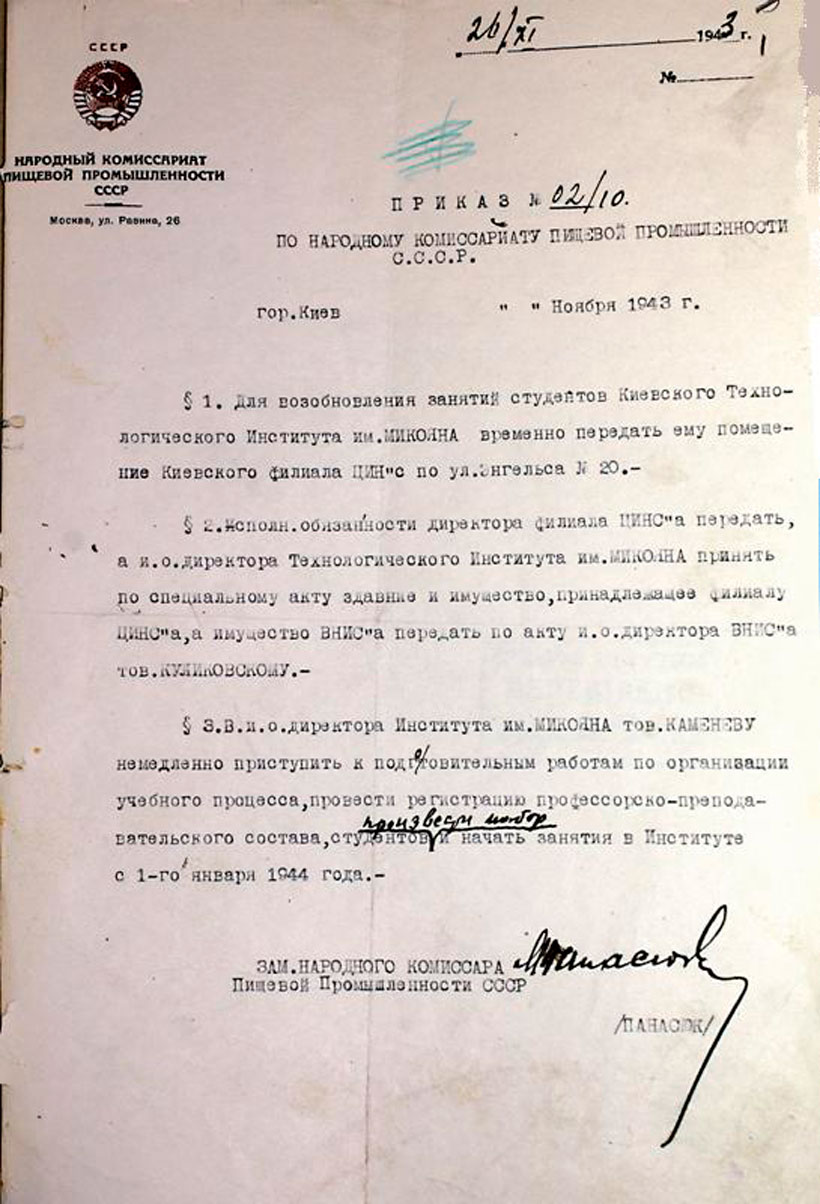
Order of the People's Commissariat of Food Industry on resuming of educational process in the Institute
-
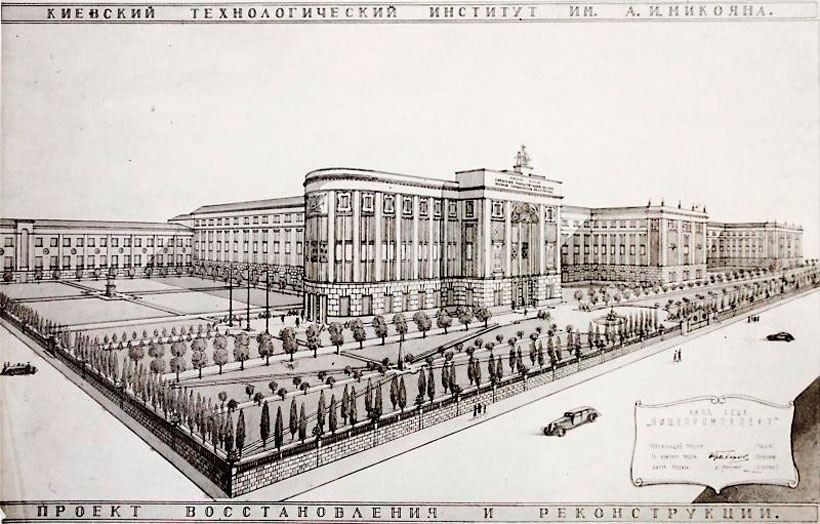
Institute Reconstruction Project (1944)
BEGINNING OF THE PROSPERITY PERIOD (1945-1974)
After the war, as educational and production base of KTIFI was destroyed, the government authorities decided to rebuild the institute on a new location between Volodymyrska, Tarasivska and Leo Tolstoi streets in the city center. Considerable funds were allotted for the construction of a new academic building designed for 2,500 students, two student hostels, two residential buildings for the teaching staff, cultural and administrative buildings.
In 1947, I.G. Hrytsiuk was appointed the Minister of Food Industry and then he worked in the civil service.
P.D. Fedorov, the new rector, continued the development of the institute (1947-1962). P.D. Fedorov graduated from Smila Sugar Institute. Since 1935, he worked as a teacher at KTIFI, then a deputy dean of the mechanical faculty. In in 1941 he volunteered to the front, was awarded a number of war decorations. His life was terminated by critical illness at the age of 59.
The institute was developing rapidly. In the middle of the 1950s, the first stage of a large-scale reconstruction was completed: the sections of the main building, the assembly hall which sat 800 people, hostels, and residential buildings were put into operation; production capacity increased. This work was organized by both war veterans and those who returned from the evacuation: V.O. Anistratenko, V.T. Hariazha, M.O. Arkhypovych, H.S. Demchuk, L.H. Prylypko, H.Yu. Dmytrenko, I.M. Holovenko and many others who successfully completed their studies at the institute, defended their candidate and doctoral dissertations, headed the most important sections of the administration, dean’s offices, departments.
From September 1962 to April 1963, the institute was headed by V.V. Beliavskyi. In this period, the development of the educational institution continued, and the student body increased in number. Thus, if in the academic year of 1959-1960 440 students were enrolled, then in the academic year of 1962-1963 990 students were enrolled (400 of them in the full-time department and 590 in evening and extramural departments).
When Radnarhosps (Councils of National Economy) were liquidated, I.G. Grytsiuk returned to KTIFI as a rector. Being the head of the educational institution for the second time, he decided to create a real polytechnic institute. Opening of new faculties was the first step to reach this aim. On the basis of the existing technological faculty, the faculties of technology of sugar substances and technology of fermentation production were created; the faculty of thermal power engineering and automation has been separated from the faculty of mechanical engineering. The second step was the renewal of the work of the faculty of economics, which was earlier moved to Odessa. The next step was the opening of a new faculty in 1965 – the faculty of technology of meat and dairy production. New departments and laboratories were also created. Leading scientists–academicians Y.Z. Shtokalo, professors V.M. Stabnikov, A.A. Naumov, O.M. Shalygin, M.S. Pasichnyk and others were invited to work at the institute due to the initiative of the rector.
Educational process continued to be equipped with new technical facilities.
The library assisted considerably students and teachers in educational process. At that time the library accounted for about 400 thousand copies of literature. In 1964 the library moved into a new building with an area of 1800 square meters.
From 1965 to 1970, scientific research increased by 3.5 times as compared with the previous period, and the economic efficiency of research implementation increased by almost 7 times.
Student’s on-the-job training strengthened the ties between science and production. According to the orders of the main departments of the ministries, the institute used 120 sugar refineries, 36 destilleries, 27 confectionery factories, 52 bakery factories, 27 breweries and 6 plants of medical preparations and protein vitamin concentrates for on-the-job training. As the number of students grew, new specialities were opened, new departments were organised, the administration adopted a decision to reequip student hostels located within the institute campus and use them as educational buildings. At the same time, the construction of student hostels and a student campus began on Nauky Avenue.
In the 1960, KTIFI held the position of the leading higher educational institution training specialists for the food industry not only in Ukraine, but also in the USSR.
From 1970 to 1973, the institute was headed by I.M. Fedotkin, doctor of technical science, professor, outstanding scientist in the field of heat and mass transfer processes, author of hundreds of scientific papers, dozens of books, inventor’s certificates and patents for inventions, who personally supervised 78 candidates of sciences and 11 doctors of science.
During these years, educational and production base was strengthened, the housing facilities and cultural and social conditions of students were improved. In 1972, after the reconstruction of school №45 which was incorporated into university campus, a new educational and laboratory building was put into operation, a hostel for 665 students was opened, and another hostel for 643 students was opened in 1973.
In the early 1970s, in accordance with the Statute, KTIFI had eight faculties: mechanical, heat and power engineering and automation of food production, technology of sugar production, technology of bakery production, technologies of fermentation, technology and equipment for meat and dairy industries, engineering-economic and general technical. They had 32 departments.
As of 1 January 1971, the teaching staff comprised 362 teachers, including 18 doctors of science and 208 candidates of sciences.
-
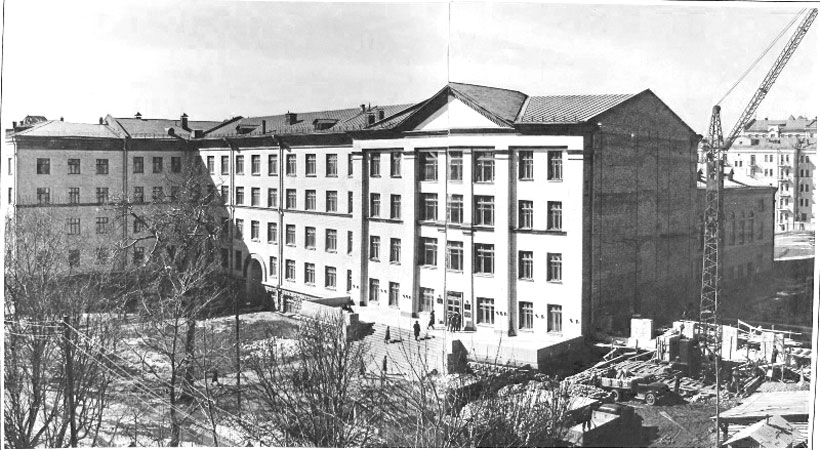
The first stage of the reconstruction is completed
-
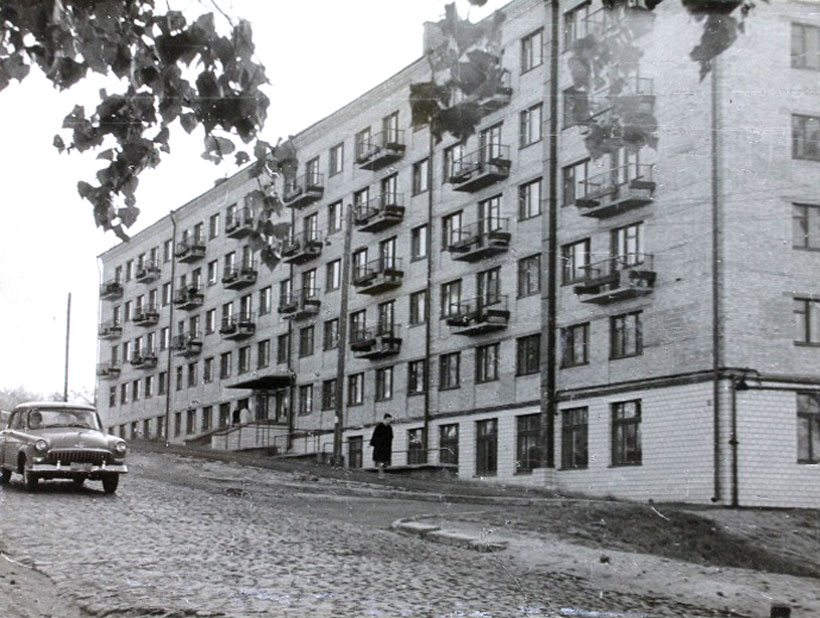
Student’s hostel (1960s)
-
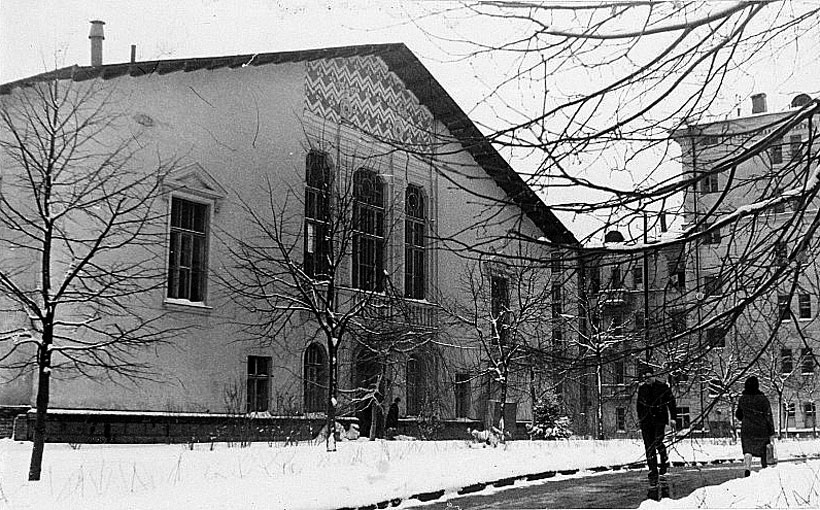
Library moved into its own premises (1964)
-
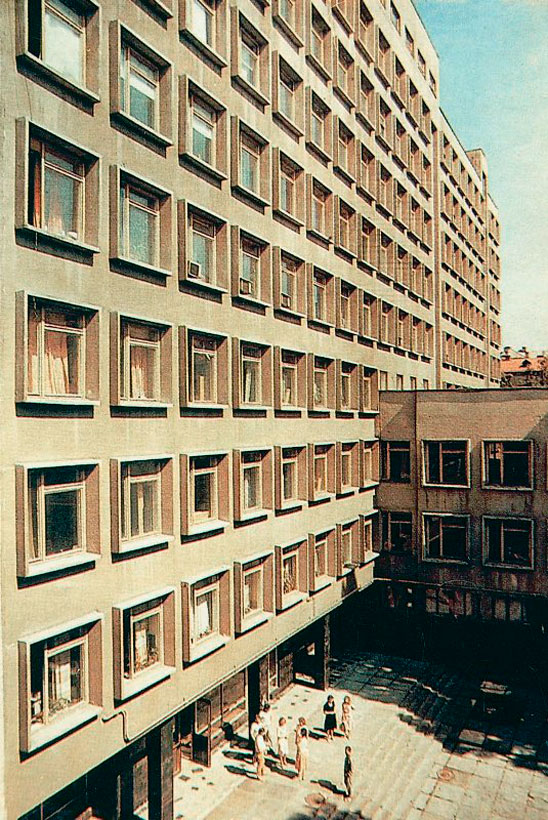
New educational building was put into operation (1972)
STEADY PROGRESS (1974-UNTILL NOW)
From 1974 to 2003, І.S. Hulyi was the rector of KTIFI, and later USUFT (since 1993) and NUFT (since 2002). І.S. Hulyi was a Doctor of Technical Sciences, professor, academician of the Ukrainian Academy of Agrarian Sciences, laureate of the State Prize in Science and Technology, Honoured Scientist and Engineer.
In the difficult transitional period, in the years of formation of independent Ukraine, I.S. Hulyi managed to unite the teaching staff to solve new tasks both in the branches of traditional food technologies and in creation of industry of healthy nutrition in Ukraine. Due to the initiative of I. Hulyi and with his participation, new specialty “Health-improving and Preventive Products Technology” was licensed for the first time in Ukraine in 1999. Since that time, the scientific-pedagogical staff and university graduates take on the responsibility for the health of the Ukrainian nation.
In 1980, KTIFI was awarded the Order of the Red Banner of Labour for its achievements in training of highly qualified specialists for the national economy and development of food technology science.
These were the years of confident progress: the material and technical base of the instite doubled, the number of students increased by four times, teachers’ qualifications improved significantly, new structural units, departments and faculties were created: faculty of engineering faculty; faculty of automation and computer systems; faculty of accounting, finance and business. In order to improve the quality and efficiency of educational process, a technical teaching aids department was created; educational documentaries and slide films were filmed. In the mid 1980s, KTIFI was the only higher educational institution in Ukraine that used a closed colour television system in educational process.
New buildings – a laboratory building with a total area of 10,878 square meters (1982), a student caanteen, sports complex (1998) – are a striking example of the improvement of the material and technical base of the institute of that time.
In 1993, according to the results of the state accreditation, KTIFI was granted the status of a higher state educational institution of IV level of accreditation and was renamed the Ukrainian State University of Food Technologies.
In 2002, taking into account the national and international recognition of the results of the University activities, its significant contribution to the development of national education and science, the university was granted the status of the National by the Decree of the President of Ukraine. Since that time it is referred to as the National University of Food Technologies.
This status is a recognition of the past achievements of the teaching staff in training specialists for the national economy and significant scientific achievements, as well as current role of NUFT in training highly qualified specialists and scientists of all specialties of the food industry, applied mechanics, automated computer systems, economics and finance, hotel-restaurant and tourism business.
From 2003 to 2010, professor A.I. Ukrainets, a graduate of the University, Doctor of Technical Sciences, headed NUFT.
During that time, the process of NUFT integration into the European and world educational space resulted in joining the IUFоST (World Organization for Food Science and Technology), a non-profit association of national organizations of specialists and food industry researchers. The material and technical base of the university, work and life conditions of students and teachers improved.
In November 2004, a new structural unit – the Faculty of Pre-University Education – was created based on preparatory courses that worked at the University since 1961.
In 2007, as new specialities opened, namely the faculty of technology of sugary substances and functional food products was reorganized into the two ones: the faculty of technology of health products and hotel and restaurant business and the faculty of biotechnology and ecology.
On 6 May 2009, the National University of Food Technologies was admitted to the International Association of Universities (IAU).
From September 2010 to November 2014, the University was headed by Professor S.V. Ivanov, Doctor of Chemical Sciences.
The new rector maped out new frameworks in the development of the university. Thus, in November 2010, the National University of Food Technologies became a co-founder of the Science Park of Taras Shevchenko National University of Kyiv.
In the same year, the university joined the National Technology Transfer Network (NTTN), whose mission is to transfer technology between the scientific and industrial sectors of the economy, as well as to search partners for cooperation in the development and implementation of new high-tech technologies.
In the same period of time, the university became a member of the European Assosiation of Integrating Food Science and Engineering Knowledge Into the Food Chain (ISEKI-Food Assosiation).
From November 3, 2014 to April 2020, the university was once again headed by Doctor of Technical Sciences, Professor A.I. Ukrainets.
On his initiative, the curricula, according to which both "bachelor's" and "master's" students are trained at the university, were brought into line with European ones. For this, the graduate departments together with the department of international relations carried out thorough and painstaking work - contacts were established with leading higher educational institutions in Europe, study plans and the order of organization of the educational process were studied. Since then, our teachers have been training in related specialties at universities in the Netherlands, Germany, Poland, Slovakia, Switzerland, etc.
Students of higher education listen the individual subjects of their choice in English, lectures by famous professors from leading European educational institutions, participate in academic mobility projects, which contributes to the integration of graduates of the National University of Food Technologies in the European and global scientific and economic area.
In November 2020 Doctor of technical sciences, professor Oleksandr Shevchenko was elected as the rector. The will of the team of the educational and scientific complex of the university was approved by the Ministry of Education and Science of Ukraine, and in December 2020, the relevant contract was concluded between the Ministry of Education and Culture and O. Shevchenko.
Since then, the optimization of the management infrastructure, the growth of the executive responsibility of intra-university structural divisions due to the expansion of their autonomy, the creation of a modern information system for university management, the implementation of an effective system for the use of university resources, the implementation of an energy saving program, the optimization of electricity, water and heat costs, the development of corporate culture and academic integrity have begun.
In the educational process, new technologies and teaching methods began to be used more widely, the process of improving the distance form of education is constantly ongoing, the dual form of education is actively developing, for the first time in Ukraine, interdisciplinary educational and scientific programs for training students of higher education at the second (master’s) level of higher education were developed and implemented , the internal system of quality assurance of higher education functions successfully and is actively being improved.
The expansion of international cooperation of the university with foreign higher education institutions, associations, firms and foundations of foreign countries continues, the participation of education seekers, scientists and teachers in international grant projects and academic mobility programs has intensified, scientific periodicals of the university have entered the scientific databases Scopus and Web of Science, conditions have been created for the effective internship of professors and teaching staff in leading foreign educational and scientific centers.
Active cooperation with stakeholders is being developed, with the help of which educational and scientific centers and laboratories are being created, the laboratory base of the departments is being modernized, guest lectures are given for students of education, practical classes are held in industrial conditions, students of education receive opportunities for practice and internships.
Today, the National University of Food Technologies is a leading higher educational institution that trains highly qualified specialists for all branches of the economy.
Currently, the university includes 3 educational and scientific institutes, 3 faculties, 37 departments, 29 of which are graduation; 2 institutes of postgraduate education, 11 colleges, 2 branches located in different regions of Ukraine; a developed scientific and research part, the center of which is the Problem Scientific and Research Laboratory.
The teaching staff of the university includes about 500 teachers. Among them: 12 academicians, almost 80 professors and doctors of science, more than 350 candidates of science. In total, more than 15,000 students and more than 5,500 scientific and pedagogical staff work in the educational complex of the National Technical University of Ukraine. The licensed number of students is 8,565. Highly qualified specialists are trained in postgraduate and doctoral studies. The university has 6 specialized academic councils for the defense of the thesis in 10 scientific specialties. Important links of the scientific-methodical and information support of the educational process are the scientific library, the funds of which are more than 1 million copies of literature; editorial and publishing complex; extensive INTERNET network, in particular the institutional repository.
Preserving and developing the positive experience of domestic education, the university perceives and implements the best global standards of training specialists. This ensures social security of graduates, increased demand for them in industry and business. The competition for admissions during the annual recruitment of students is also constantly increasing.
The prompt response of the university management to the trends of the labor market creates a solid basis for maintaining the educational institution at the world level of education. The humanitarian training of students is also aimed at this, focused on the active creative activity of specialists in various branches of the economy, as well as on their awareness of responsibility to the people of Ukraine, the need to inherit spiritual heritage, the formation of a high culture of international relations, the acquisition of social experience, and the establishment of a civil democratic society.
Today, the National University of Food Technologies is an educational institution with great scientific potential. The 35 scientific schools of the university are widely known in Ukraine and abroad in 16 thematic areas of scientific research and scientific and technical development. Enriched with modern content, they are now closely related to scientific and technological progress and determine its priorities in the field of food technology.
University scientists are the authors of a huge number of inventions, their scientific achievements are highly appreciated at the state level - more than 40 scientists have become laureates of the State Prize of Ukraine in the field of science and technology.
During the 30 years of independence, university employees have received more than 2,000 Ukrainian patents for inventions and useful models, including more than 1,000 in co-authorship with students. In addition, 27 patents and 2 copyright certificates were obtained outside of Ukraine.
The work on renewing and signing agreements on cooperation with foreign higher education institutions in the field of food has been significantly strengthened. Currently, there are more than 50 agreements on joint scientific and technical activities with related universities, in particular - the Higher Institute of Food and Flavor Industry in Plovdiv (Bulgaria), the Slovak Polytechnic Institute (Slovakia), the Hanoi Polytechnic Institute (Vietnam), the Compiègne University of Technology (France), Lublin and Białystok Polytechnics (Poland), Munich University and Potsdam Grain Processing Institute (Germany). Contacts have been established and directions for further academic cooperation with the University of Pennsylvania (USA) and the University of Manchester (Great Britain) have been outlined. On June 9, 2011, NUFT was accepted into the Network of Universities of the Black Sea Region; in September of the same year, the educational institution joined the Great Charter of Universities. In 2012-2015, the university worked on the international scientific project PRORES (Pro-ecological restructuring for job) of the Seventh Framework Program of the European Union to support training and career development of researchers. Since 2019, new projects of the Erasmus+ program based on the Jean Monet module have been successfully implemented and selected every year.
The university's achievements are the result of the selfless work of all generations of its teachers and scientists, as well as university leaders, from the first head of technical classes M.A. Bunge to the current rector, professor O. Shevchenko. Every student and graduate of the university is aware of his great involvement in the general cause, in the image of his educational institution, its traditions and in the development of an independent Ukraine. The life motto of our graduates is the slogan: "No one has done this before - we are the first!". And with him, the university is oriented towards the future.
-
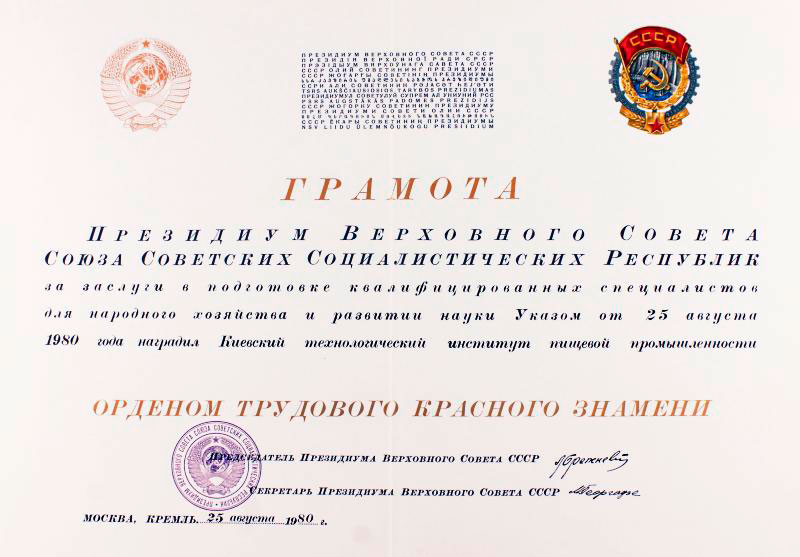
Certificate of the Presidium of the Supreme Soviet of the USSR on awarding the Institute with the Order of the Red Banner of Labour (1980)
-
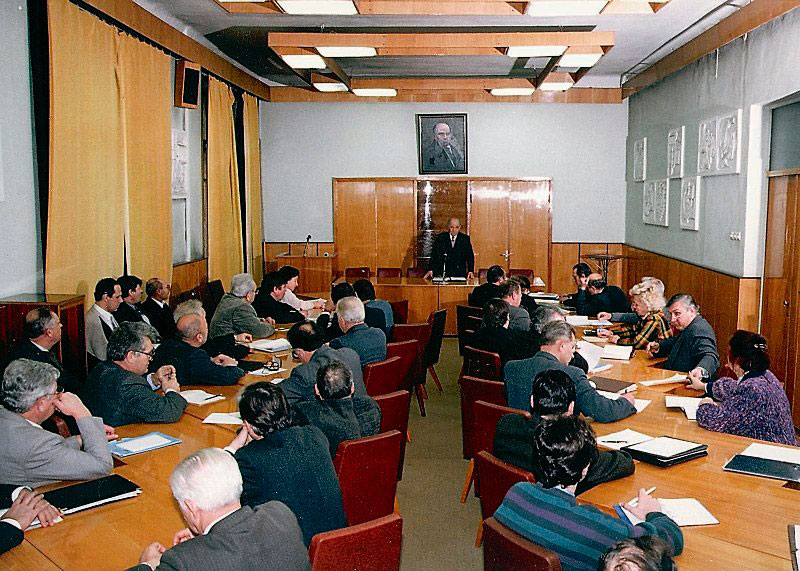
Meeting of the Academic Council of the Institute (1985)
-
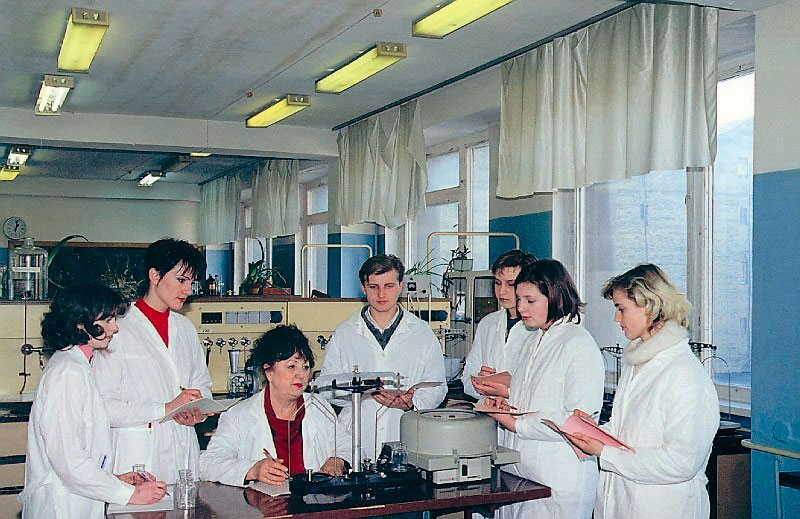
Educational process at the department of milk and dairy technology (1990s)
-
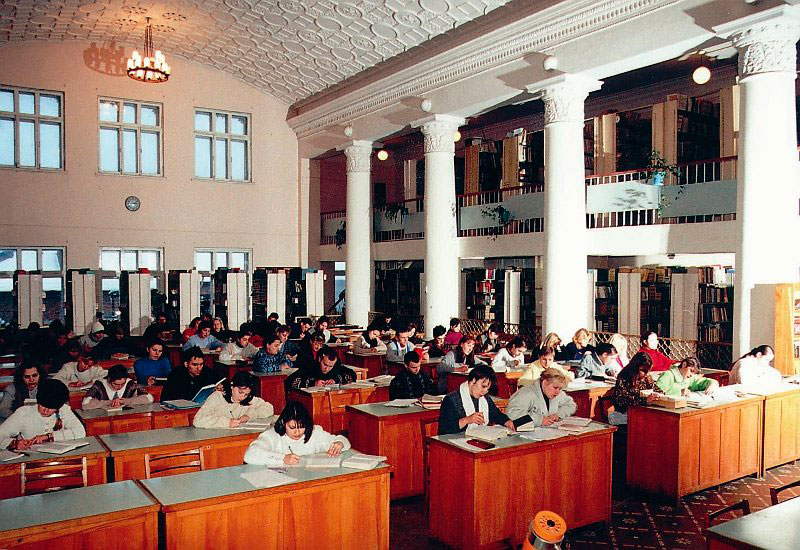
Reading room for students of the Scientific and Technical Library (1990s)
-
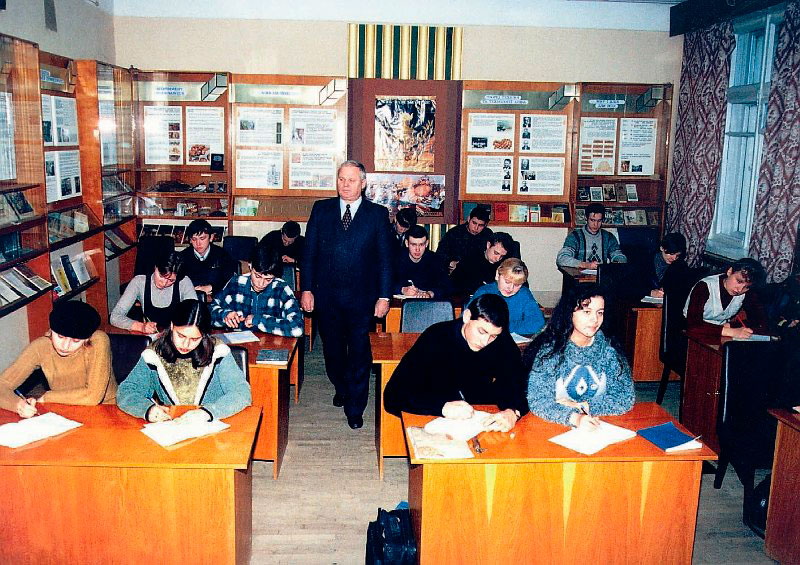
Educational process (2003)
-
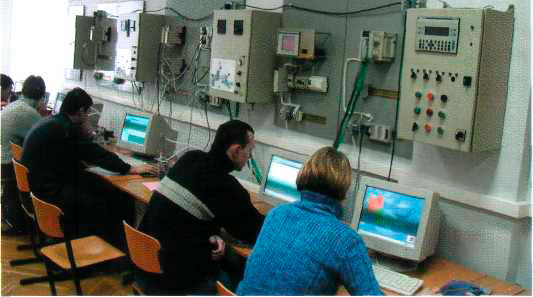
In the laboratory of microprocessor technology (2005)
-
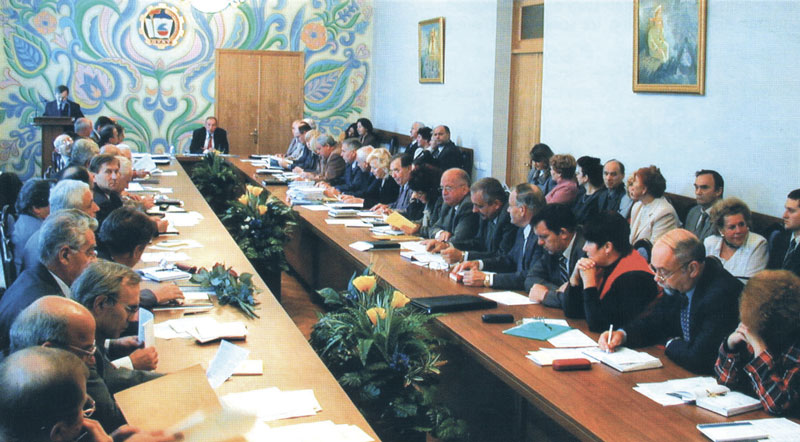
Meeting of the Academic Council of the University (2008)
-
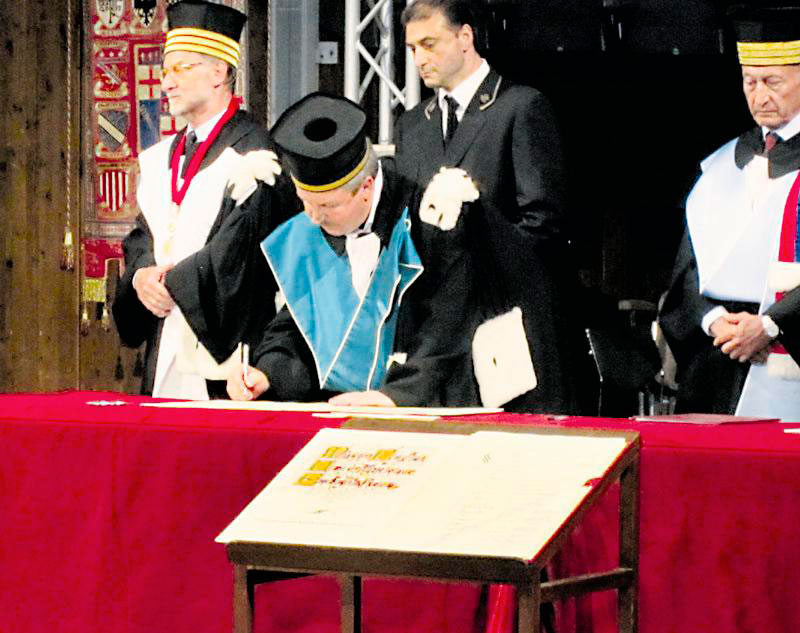
Signing of the Great Charter of the Universities (2011)
-
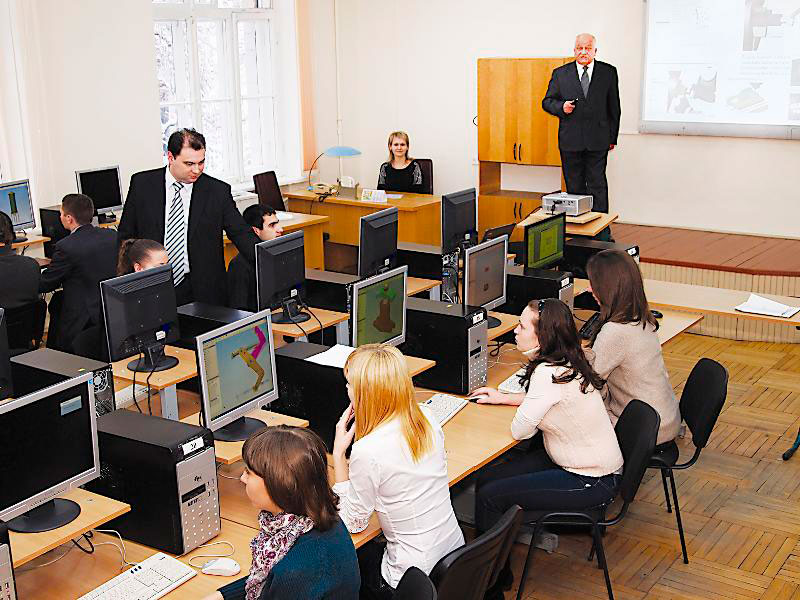
Practical class at the department of technological equipment and computer aided design (2012)
-
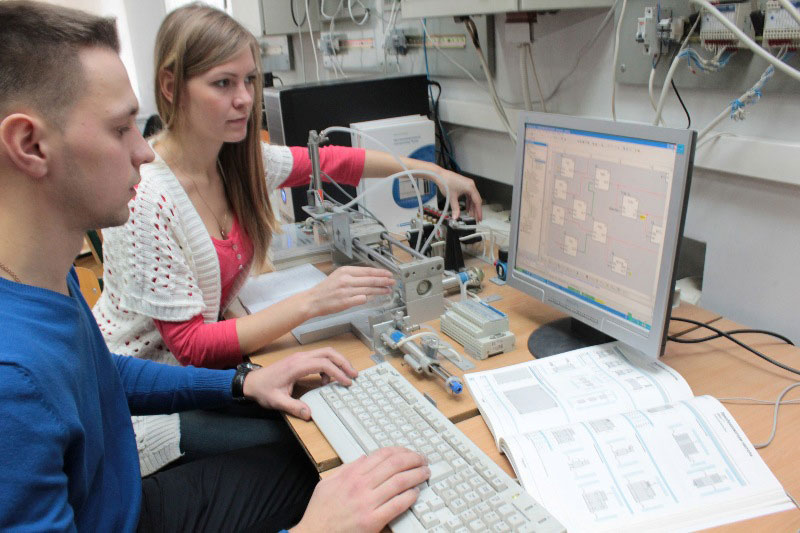
Laboratory work at the department of
integrated automated control systems (2012)
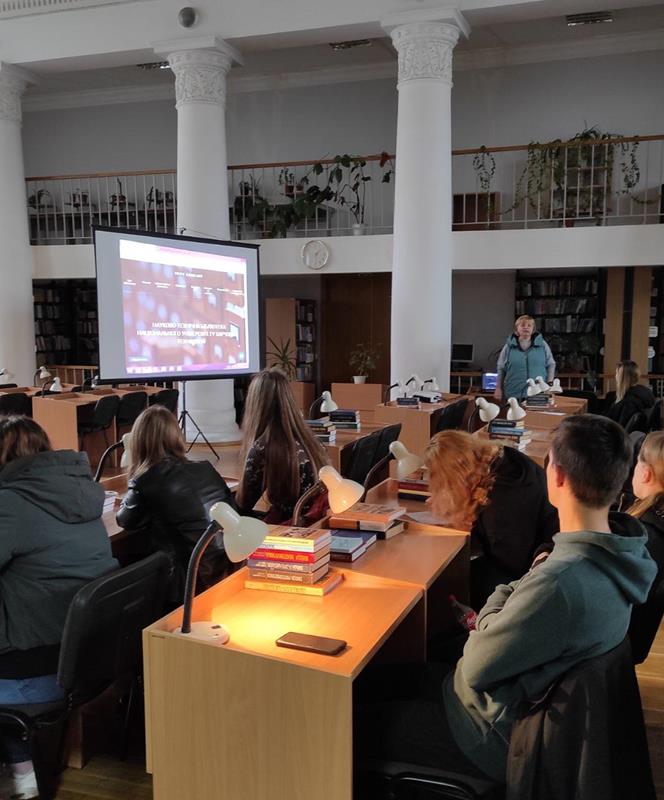
Acquaintance with the resources of the Scientific and Technical Library (2018)
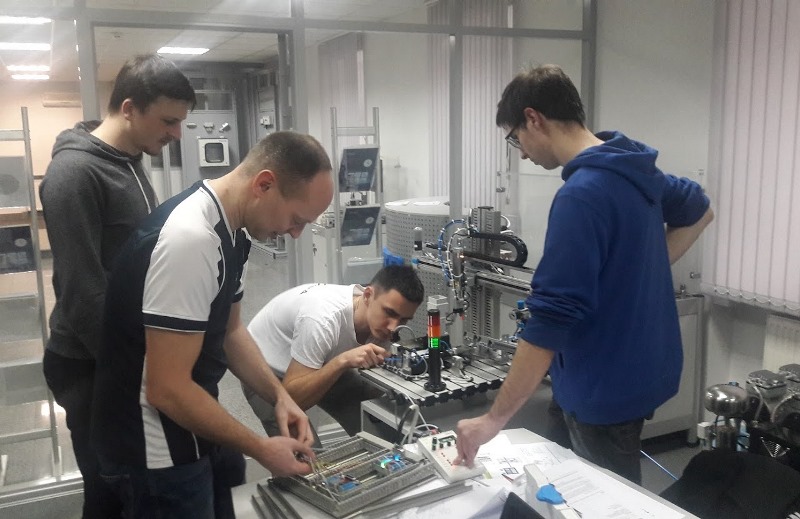
Practical work in the mechatronics laboratory (2021)
-
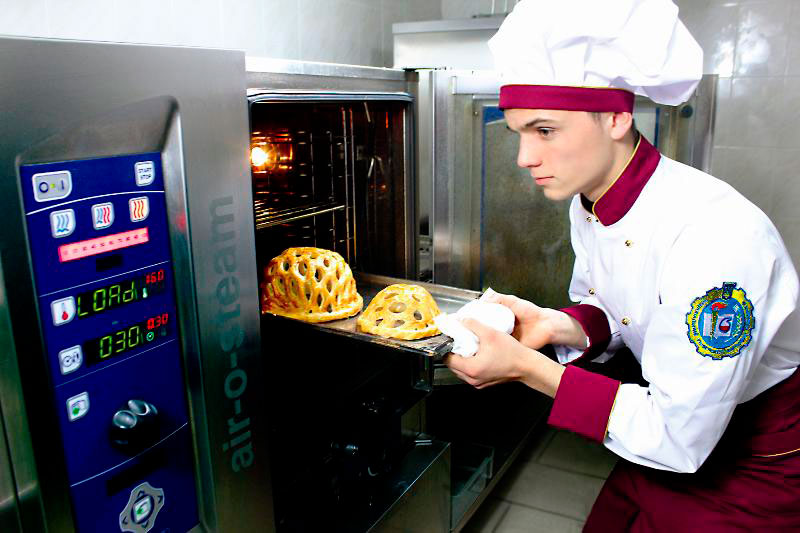
Practical classes in the nutrition laboratory (2013)
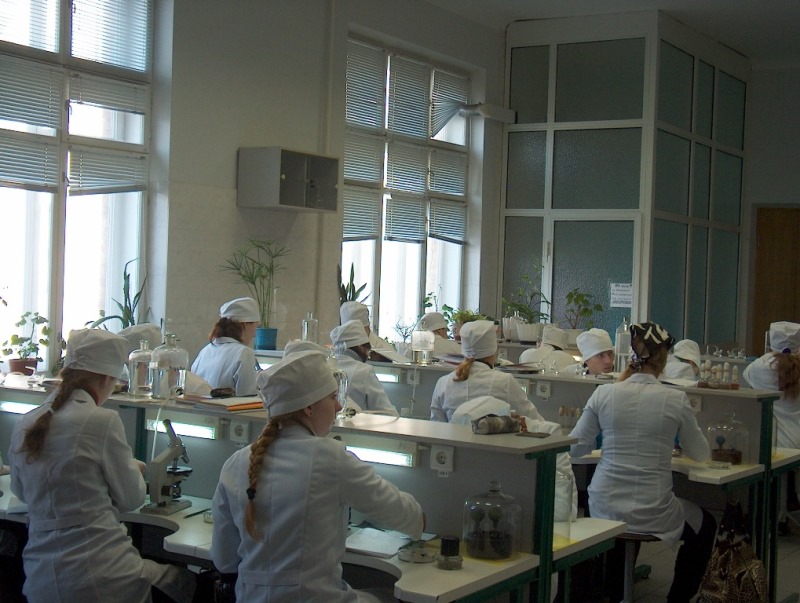
Laboratory work in a biotechnology laboratory (2020)
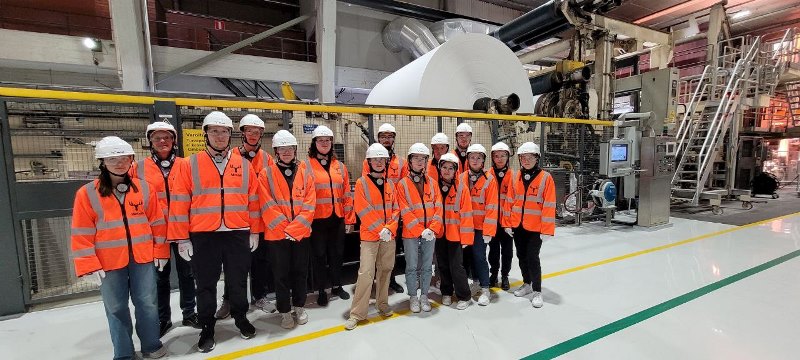
Internship of applicants at the Finnish company Metsa Board (2023)
-
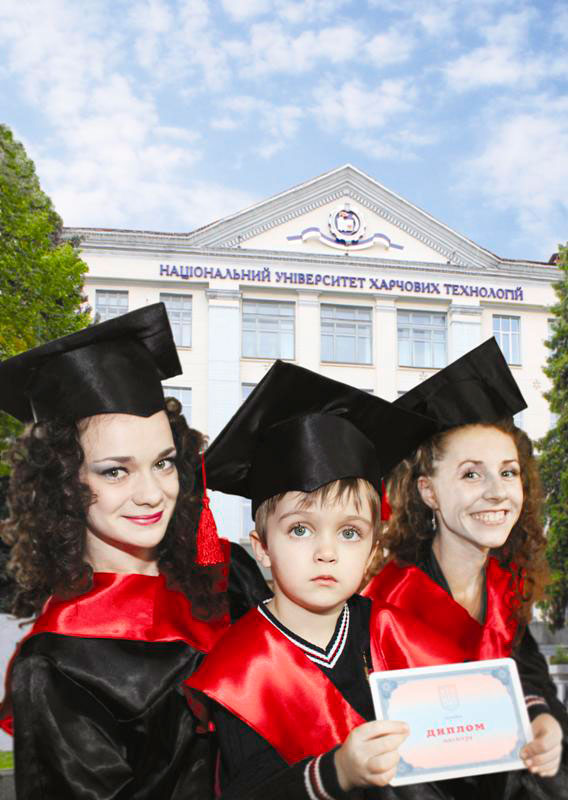
Continuity of generations
Guest lecture by a Dutch scientist (2021)
Forum "Innovative approaches in industrial and craft production: challenges and opportunities" (2023)



